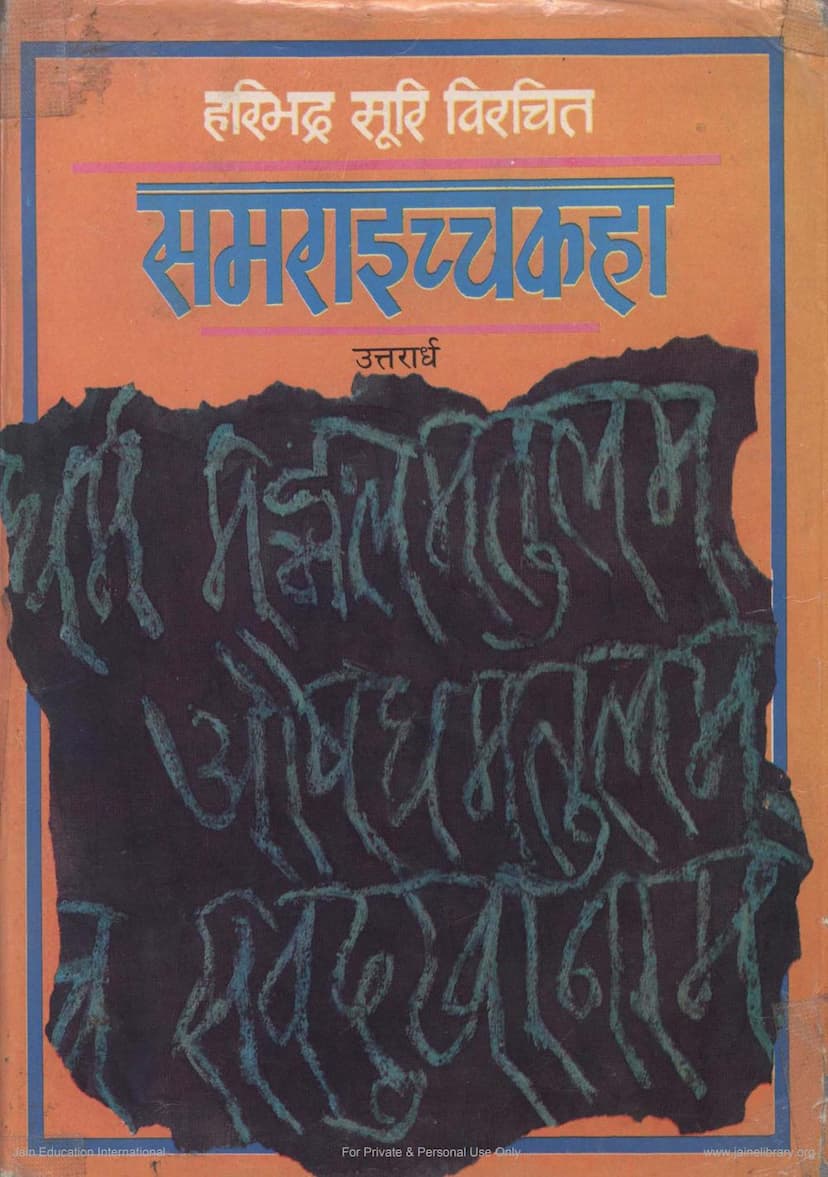Samraicch Kaha Part 2
Added to library: September 2, 2025

Summary
This is a comprehensive summary of the provided Jain text, "Samraicch Kaha Part 2," authored by Haribhadrasuri and edited/translated by Rameshchandra Jain. The text is an important work in Jain literature, often compared to renowned Sanskrit works for its narrative style and philosophical depth.
The book is the second volume of the "Samraicch Kaha" (also known as Samaraditya-katha), a significant narrative work in Prakrit prose. It is described as a great Prakrit novel that depicts the life-long struggles and conflicts between the protagonist and the antagonist across various lifetimes. The core story details the nine births (bhavas) of Ujjain's king Samaraditya and his antagonist, Agnisharma. Each birth's story is contained within a single chapter, resulting in nine such chapters or episodes.
The publication by Bharatiya Gyanpith is highlighted as a significant achievement, offering a well-edited and authentic Hindi translation alongside the original Prakrit text and its Sanskrit commentary (chhaya). The book is substantial in size and is divided into two volumes: the "Purvardha" (first part) containing the first five lives, and the "Uttarardha" (second part) containing the final four lives. This volume is specifically the "Uttarardha."
The provided text then delves into the sixth birth (छठ्ठो भवो), commencing with a dedication and moving into the narrative. Here, the story focuses on:
- The City of Makandi: A prosperous and ethically sound city where kings like Kalamegha, known for his strong stance against enemies and his just governance, reside.
- The Wealthy Seth Bandhudatta: A highly respected and virtuous merchant residing in Makandi. He is depicted as virtuous, generous, and committed to good deeds.
- Haraprahā: Bandhudatta's wife, who shares his noble qualities and their shared life of virtue and happiness.
- The Divine Rebirth: The narrative shifts to a heavenly being descending to be born as Dhaṛa, the son of Bandhudatta and Haraprahā. Haraprahā's dream of auspicious events surrounding the birth of her son is described, symbolizing wealth and prosperity.
- The Conflict Between Dharana and Lakshmī: The story introduces Vijay, who is reborn as Lakshmī, Dharana's wife. Despite Dharana's love for Lakshmī, her heart is elsewhere, leading to internal conflict and dissatisfaction with her life.
- The Incident at the City Gates: A quarrel erupts between Dharana and Devnandi, the son of Seth Panchanandi, at the city gates due to their chariots blocking the path. This dispute escalates, requiring intervention from the city elders and eventually leading to the temporary departure of both young men to seek their fortunes elsewhere.
- The Journey of Dharana and Devnandi: Both depart to different regions to gain wealth and experience.
- Dharana's Encounter with Vidyadhar Kumar: While traveling with a merchant caravan, Dharana encounters a beautiful Vidyadhar Kumar in a forest. The Vidyadhar, named Hemkundala, explains his distress stems from a sorceress who abducted Jayashri, the princess of Ujjain, who was to marry Shrivijaya. Hemkundala seeks a medicinal herb from the Himalayas to cure Shrivijaya, who was injured in the fight to rescue Jayashri. Dharana, upon hearing this, decides to help by going to the Himalayas to retrieve the herb.
- Dharana's Quest and Return: Dharana successfully obtains the herb and returns. He encounters Hemkundala again, and through a display of strength and intelligence, helps Hemkundala find the correct path to his desired destination.
- Encounter with Kalasen: Dharana later encounters a dying chief of the Shavaras named Kalasen, who was mortally wounded by a lion. Dharana uses the medicinal herb to heal Kalasen. In gratitude, Kalasen pledges his loyalty and offers his wealth.
- The Struggle with Pirates and the Resolution: The caravan faces an attack by robbers. Dharana, along with Kalasen and his men, fights bravely. The text then describes the further adventures of Dharana, including his encounter with the villainous Chanda Rudra, his rescue of a charlatan thief, and his eventual return to his homeland, where he is celebrated for his achievements.
- The story of Dharna and Lakshmi's Past Lives: The text then extensively details past lives, illustrating the intricate karmic connections and the eventual reunion and separation of characters like Dharana and Lakshmī, emphasizing the Jain principles of karma and reincarnation. This includes descriptions of their births as celestial beings, kings, and other beings, highlighting their interactions and the consequences of their actions.
The summary concludes with the mention of the seventh birth (सत्तमो भवो), detailing the story of Sen Kumar and Vishen, their karmic journey, and their eventual rebirth as celestial beings, and then in human form as characters related to the protagonists of the main narrative. The narrative highlights the Jain emphasis on virtue, detachment from worldly pleasures, and the pursuit of spiritual liberation through righteous conduct.